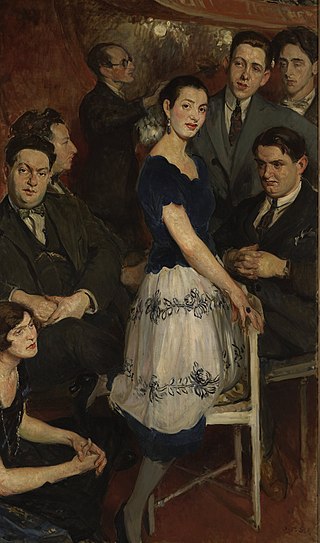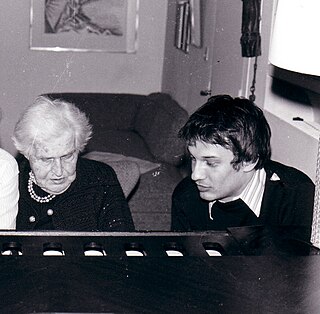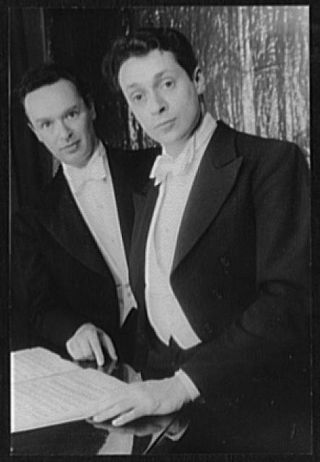Related Research Articles

"Les Six" is a name given to a group of six composers, five of them French and one Swiss, who lived and worked in Montparnasse. The name, inspired by Mily Balakirev's The Five, originates in two 1920 articles by critic Henri Collet in Comœdia,. Their music is often seen as a neoclassic reaction against both the musical style of Richard Wagner and the impressionist music of Claude Debussy and Maurice Ravel.

Germaine Tailleferre was a French composer and the only female member of the group of composers known as Les Six.

The Piano Concerto in A minor, Op. 54, by the German Romantic composer Robert Schumann was completed in 1845 and is the composer's only piano concerto. The complete work was premiered in Dresden on 4 December 1845. It is one of the most widely performed and recorded piano concertos from the Romantic period.

Sergei Rachmaninoff's Piano Concerto No. 3 in D minor, Op. 30, was composed in the summer of 1909. The piece was premiered on November 28 of that year in New York City with the composer as soloist, accompanied by the New York Symphony Society under Walter Damrosch. The work has the reputation of being one of the most technically challenging piano concertos in the standard classical piano repertoire.

Carnaval, Op. 9, is a work by Robert Schumann for piano solo, written in 1834–1835 and subtitled Scènes mignonnes sur quatre notes. It consists of 21 short pieces representing masked revelers at Carnival, a festival before Lent. Schumann gives musical expression to himself, his friends and colleagues, and characters from improvised Italian comedy. He dedicated the work to the violinist Karol Lipiński.
"Deux poèmes de Lord Byron" are the only known songs set to an English text by Germaine Tailleferre and date from 1934. Although Tailleferre's manuscript has disappeared, a photocopy was found in the papers of the Italian mezzo-soprano and musicologist Patricia Adkins Chiti, who provided a copy which served as the source for their publication in 2003 by the French publisher Musik Fabrik.
"Pancarte pour une porte d'entrée" is a cycle of eleven songs composed by Germaine Tailleferre to the poems of the novelist and poet Robert Pinget written in 1959. The work was published in 2000 by the French publishers Musik Fabrik.
Alice Theresa Hildagard Swanson Esty was an American actress, soprano and arts patron who commissioned works by members of Les Six and other French composers, and American composers such as Ned Rorem, Virgil Thomson. Claire Brook, and Marc Blitzstein, among others.
"L'adieu du cavalier" is a song for voice and piano written by Germaine Tailleferre in 1963 on a poem of the same title by Guillaume Apollinaire. The work was published in 2003 by the French publishers Musik Fabrik.
The Sonate champêtre is a chamber work for oboe, B♭ clarinet, bassoon and piano written by Germaine Tailleferre in 1972. The work was published in 2003 by the French publishers Musik Fabrik.

Arthur Gold and Robert Fizdale were an American two-piano ensemble; they were also authors and television cooking show hosts.
The Toccata for Two Pianos is a work by Germaine Tailleferre, written in 1957 for the American two-piano team Gold and Fizdale, to whom it is dedicated. The work was published in 1999 by the French music publisher Musik Fabrik.
The Sonata for Two Pianos is a work by Germaine Tailleferre written in 1974 for the American two-piano team Gold and Fizdale, to whom it is dedicated. The work was published in 1999 by the French music publisher Musik Fabrik.

Marcelle Meyer was a French pianist. She worked with a group of composers known as Les Six, of whom she was the favored pianist.
Wilfrid Van Wyck was a British classical music artists impresario and manager through his agency, Wilfrid Van Wyck Ltd, based in London. He was the second president of the European Association of Artist Managers.

The Piano Quartet No. 1 in G minor, Op. 25, was composed by Johannes Brahms between 1856 and 1861. It was premiered in 1861 in Hamburg, with Clara Schumann at the piano. It was also played in Vienna on 16 November 1862, with Brahms himself at the piano supported by members of the Hellmesberger Quartet. Like most piano quartets, it is scored for piano, violin, viola and cello.

Klang —Die 24 Stunden des Tages is a cycle of compositions by Karlheinz Stockhausen, on which he worked from 2004 until his death in 2007. It was intended to consist of 24 chamber-music compositions, each representing one hour of the day, with a different colour systematically assigned to every hour. The cycle was unfinished when the composer died, so that the last three "hours" are lacking. The 21 completed pieces include solos, duos, trios, a septet, and Stockhausen's last entirely electronic composition, Cosmic Pulses. The fourth composition is a theatre piece for a solo percussionist, and there are also two auxiliary compositions which are not part of the main cycle. The completed works bear the work (opus) numbers 81–101.

The Novelletten, Op. 21, is a set of eight pieces for solo piano, written by Robert Schumann in 1838. This composition is dedicated to Adolf von Henselt.
The Sei pezzi per pianoforte, P 044, is a set of six solo piano pieces written by the Italian composer Ottorino Respighi between 1903 and 1905. These salon pieces are eclectic, drawing influence from different musical styles and composers, particularly music of earlier periods. The pieces have various musical forms and were composed separately and later published together between 1905 and 1907 in a set under the same title for editorial reasons; Respighi had not composed them conceiving them as a suite, and therefore did not intend to have uniformity among the pieces. The set, under Bongiovanni, became his first published works. Five of the six pieces are derived from earlier works by Respighi, and only one of them, the "Canone", has an extant manuscript.
References
- ↑ "Germaine Tailleferre: Intermezzo for two pianos". MusikFabrik. Retrieved September 11, 2022.
- ↑ Epstein, Louis K. "Germaine Tailleferre". OBO in music. doi:10.1093/OBO/9780199757824-0275.